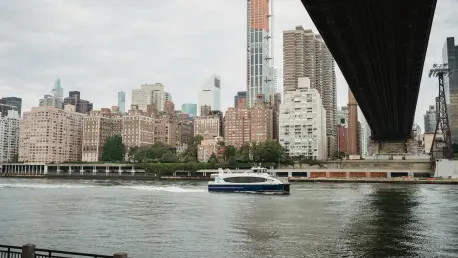A construction accident in New York has brought the complex interplay of labor and insurance laws into sharp focus, drawing attention to the rigors of New York’s Labor Law § 240(1). This incident, involving a worker injured by a failed hoist system, has initiated a detailed legal examination, revealing intricate legal layers and pointing out significant liabilities in construction activities. The case underscores the necessity for functional hoisting equipment on job sites, as well as complex insurance and indemnification issues that may not always straightforwardly protect involved parties.
Labor Law and Safety Compliance
Analyzing Legal Obligations and Responsibilities
New York’s Labor Law § 240(1) plays a critical role in regulating construction safety and imposing strict liability on contractors and property owners for ensuring safe working conditions. The injured worker employed by a subcontractor was using a chain block pulley to reinforce a structure with steel beams when the hoist support failed, resulting in injuries. The accident highlighted deficiencies in safety protocols, as the equipment failed to safeguard against the risk of falling objects. The legal framework under § 240(1) mandates that contractors provide safe equipment, underscoring safety compliance as paramount to liability issues. This law is notably stringent, often dismissing contributory negligence arguments to prioritize worker protection over nuanced liability discussions.
The trial court’s decision to uphold the worker’s claim under § 240(1) was aligned with the law’s emphasis on safety, reaffirming the primary responsibility on employers to provide and maintain safe equipment. The court’s finding was supported by the Appellate Division, which underscored the failure of the pulley system to prevent injury risks, therefore, marking a violation of specific safety statutes. This verdict not only reinforces a commitment to rigorous safety standards but also suggests that mere oversight or neglect in equipment maintenance can attract severe legal consequences. Such provisions highlight the stringent landscape that construction firms operate within, necessitating unwavering adherence to safety regulations to mitigate legal exposures.
Implications on Industry Standards and Practices
The implications extend beyond the immediate legal ramifications, as the case highlights broader industry practices and standards. The necessity for robust safety equipment and procedures is a compelling lesson for the construction industry, which continues grappling with challenges around compliance and enforcement. This incident serves as a potent reminder of the critical role of thorough safety audits and maintenance routines, emphasizing preventive measures to avert mishaps. Contractors are impelled to reevaluate existing protocols and invest in regular training and audits to uphold lawful practices and worker protection.
Legal scrutiny has revealed lapses in industry standards where safety concerns are sometimes sidestepped, especially in complex operations involving heavy machinery and hoisting systems. This lack also calls into question the role of inspections and regulatory oversight by authorities, aiming to bridge gaps and enhance the industry’s safety performance. The emphasis on proactive measures not only strengthens compliance but also amplifies workers’ trust in their workplace safety provisions.
Insurance and Indemnification Complexities
Navigating Insurance Coverage and Liability Issues
Apart from safety compliance issues, the accident underscores the complexities of insurance coverage and indemnification agreements. The contractor sought indemnification for damages incurred from the accident, citing their agreement with the subcontractor. However, a significant legal hurdle emerged, as the subcontractor’s insurance did not extend coverage to the contractor, highlighting procedural intricacies that frequently accompany indemnity claims. This underscores the importance of clear, comprehensive insurance agreements that preemptively address potential coverage lapses and liabilities.
Due to the misalignment between the anticipated and actual insurance provisions, the contractor retained claims for contribution and common-law indemnification. However, definitive legal resolution hinges upon the degree of injury as classified under New York’s Workers’ Compensation Law § 11, which defines “grave injury” parameters affecting liability allocations. Legal proceedings continue to examine whether the injury falls within this definition, impacting the outcome between the subcontractor and the contractor’s indemnification dynamics.
Legal Precedents and Future Considerations
This case sets a meaningful precedent in the construction industry, illustrating the legal complexities associated with insurance claims following workplace accidents. The detailed scrutiny of contractual and insurance provisions serves as a crucial reminder for all involved parties to thoroughly understand and articulate their liability and coverage obligations. Future considerations must involve meticulous drafting of contracts and a proactive approach to verifying insurance policies to avert unforeseen disputes.
Furthermore, the case accentuates the unpredictable outcomes often seen in legal proceedings, reinforcing the necessity for businesses to retain knowledgeable legal counsel familiar with construction law intricacies. Proactively addressing these complex challenges not only advances industry standards but also ensures robust protection for workers and businesses alike, mitigating future liabilities. As legal battles unfold, the construction sector must stay attuned to evolving regulations and court interpretations, embedding these insights into operational strategies and risk management practices.
Navigating a Complex Legal Landscape
A construction accident in New York City has highlighted the intricate relationship between labor and insurance laws, particularly the demanding aspects of New York’s Labor Law § 240(1). This incident involved a worker who sustained injuries due to a malfunctioning hoist system. Consequently, it has sparked a detailed legal investigation, uncovering complex legal dimensions and emphasizing significant liabilities associated with construction practices. The case highlights the critical importance of ensuring that hoisting equipment is fully operational and reliable on job sites. Moreover, it sheds light on the multifaceted insurance and indemnification challenges that are often involved in construction work. These complexities can make it difficult for the parties involved to navigate the legal landscape and achieve adequate protection. Ensuring safety and compliance in construction is crucial, not only to prevent accidents but also to address the legal and insurance nuances underlying such incidents.









